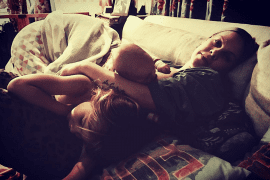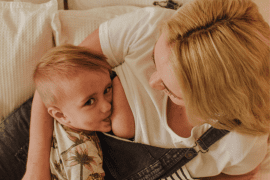3. Antenatal expression of colostrum
Lots of people on social media (who I’ve been asking about flat nipples) said they wish someone had told them about antenatal expression. It would have helped their first few days and elevated their confidence. Hand expression is a useful skill for those with flat nipples. You can use it to relieve engorgement, get some drips to motivate a baby to latch on or get a milk ejection reflex started. Part of the value of antenatal expression is ensuring hand expression feels normal and natural after baby arrives. Antenatal expression can usually happen from 36 weeks and the ABM leaflet is a good starting point.
4. Postnatal expression
Cara: “I think the thing I wish I had felt more empowered to do was give some expressed milk. I waited until someone told me I could even though my instinct was telling me to do something to get more milk into him.” Some mothers talked about receiving the message that early expression was bad or “you should wait for 6 weeks” without realising that if a baby is struggling to latch on, those rules don’t apply.
We have those three keeps: Keep baby close, Keep baby fed, Keep your milk flowing. When latching is taking a bit of time to get established, it can be tempting to spend extended periods trying to make it work, and eventually baby just falls asleep and everyone is exhausted. We need supply stimulated and baby to get milk. Sometimes a baby might start a feeding attempt with some hand expressed milk dripped into their mouth, spoon-fed or syringe-fed to get them into the right gear and motivated to latch on.
5. Does the nipple extend?
Some nipples will extend more. Some may even permanently change shape with feeding and expressing, but in the short term, a few extra millimetres of length can help. This might mean a product designed for the purpose, a short burst with a breast pump, drawing out with fingers, an adapted syringe or using a breast shell. If someone is worried about their nipple shape at the start of their pregnancy, changes may well come.
Hormones can change nipple shape and size, but evidence doesn’t suggest using devices in pregnancy will help.
6. Breast-shaping
Breast shaping can sometimes be a risk. Sometimes it does lead to the breast being pulled across to baby and offered as if someone is bottle-feeding with a breast. But when we want a baby to get a bigger mouthful of breast, it can really maximise those millimetres if done carefully. Techniques like the C-hold, V-hold or flipple may be useful.
7. Nipple shields
Repeatedly, replies talked about the value of nipple shields. They may have been used for days, weeks or months but they were often credited with making breastfeeding happen. If we lived in an ideal world, many of these nipple shields would have gone unused and un-bought. High quality breastfeeding support would have been available at any point it was needed and early latching happening without a layer of silicone between nipple and baby.
However, it goes without saying that we don’t live in that world, and to be sniffy about nipple shields may mean some babies don’t end up breastfeeding. Ideally, nipple shields are not the first solution (not least because colostrum will get lost inside and not get to baby) but they can have a place. We need parents to understand that sizing is key, not helped by the fact that many shops will only stock a medium.
There is sometimes a misunderstanding that a large size means a large long nipple when in fact, we are looking at the diameter of the base of the nipple. Someone with an entirely flat or inverted nipple may need a large size. The largest available appears to be a 28mm, only available online. Other sizing in the UK, depending on brand, includes 14.9mm, 16mm, 20mm, 21mm, 23mm, 24mm. Forget messaging about sizing according to baby’s mouth; that’s going to lead to sore nipples, compromised milk transfer and reduced milk supply.
A nipple will never be drawn comfortably inside a shield if it starts off looking like a hippo wearing a bowler hat. It’s got to be about getting a good fit on the nipple.
Putting the shield on half inside-out, by rolling up the sides and then everting it once it’s in place will create suction that draws the nipple deeper inside and help the shield to stay on. Some expressing alongside shield use and ongoing support from a qualified breastfeeding supporter is likely to be important. Many find that shields end up not being used over time or are only helpful at the beginning of a feed.
The mother from the story at the start who was told: “You’ll never get any milk out of those” went on to say, “5 years of feeding and three babies later. Nipple shields made all the difference and I use them differently with all three.”
There is such a delicate balance in conversations about flat nipples. As breastfeeding supporters, the heart of our work is about building confidence, giving positive messages about breastfeeding and offering encouragement. We are never going to be the ones that start with a “Uh-oh, you’re in trouble” but neither should we be the ones who pretend it doesn’t matter. There are times when breastfeeding may mean more challenges and as always, we give information and build confidence by helping families to feel prepared and supported.
This article previously appeared in the magazine of the Association of Breastfeeding Mothers
Originally published here.
After a career as a Deputy Headteacher in central London, Emma initially trained with UK charity Association of Breastfeeding Mothers, qualifying as a breastfeeding counsellor with them in 2007. She qualified as a Board Certified Lactation Consultant (IBCLC) in 2011. She recertified in 2016 and continues to offer voluntary support at groups across West Haringey and volunteers on the National Breastfeeding Helpline and ABM national helpline alongside her private lactation consultant work. You can find her on Instagram and on Twitter as @makesmilk. Her book, “You’ve Got It In You: a positive guide to breastfeeding” can be found on Amazon and from other retailers.










